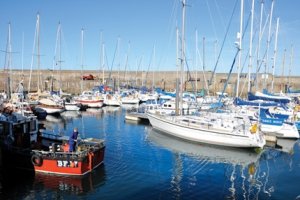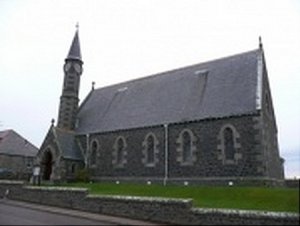Capt Lightning
Well-known Member
- Location
- Historic Buchan, Scotland
Whitehills, Blackpots, Red Wells and Aeroplanes.
Seeing seals swimming round the old harbour is pretty commonplace here, but sometimes I get lucky
and see dolphins leaping just offshore. Sometimes we're told, "Oh you should have been here yesterday, we had a Minkie whale come by". Even the occasional Orca has visited this former fishing village. You never know what you will see at Whitehills.

Our story starts in the 1700's with the rise of the fishing industry along the North Aberdeenshire coast. At that time, the small village of Whitehills did not even have a harbour. In the early days fishing boats would come
close to the shore and it was not uncommon for fishwives to carry their husbands out to the boats on their backs
so they could avoid the discomfort of going to sea in wet clothes!
The wooden fishing boats would have a crew of 3 and each man would have three fishing lines, each with 300 hooks. These would be baited each day by the the womenfolk who would also gut and salt the daily catch.
With bigger fishing boats, the advent of steam power and new fishing methods, a new harbour was needed and this was completed in 1900. For over 100 years this provided a safe mooring for the Whitehills fleet, but it too
became too small for the larger trawlers and the adjacent fish market closed early this century.
This was not the end of the harbour for it was quickly converted to a stylish marina catering for an increasing
number leisure craft.

The harbour was not the first building to be ‘recycled’. In the early 20th. century, when a new parish church was planned the locals purchased a disused church 4 miles away in Banff, dismantled it, moved it stone by stone and rebuilt it in Whitehills.

Although fishing was by far the main industry in Whitehills, at the same time, a Brick, tile and pipe factory was built in the part of the village called Blackpots. This utilised clay dug from the nearby Knock hill and transported to
the factory by a narrow gauge railway. For around 250 years the factory produced bricks, pantiles and clay water pipes.
Beside the factory was another small harbour where cargo boats would bring in coal for fuel and take away the
finished products. The factory has gone, but evidence of it remains for all to see. Broken pipes and tiles were
simply dumped on the beach and over the years, the sea has polished them smooth.
Now, take a stroll along the footpath from the old harbour towards Banff and you will see a stone dome-shaped building that houses the Red Well. This iron-rich well is believed to date back to Roman Times
although the Romans never settled this far north. Back in the 19th. century, people making a 'Grand tour' of Scotland would stop at various mineral springs to drink the water for their supposed medicinal properties. Typically the 'Health & Safety' brigade have stopped access to the well, declaring it unsafe to drink!

Finally this brings us to the role of Whitehills in World war 2 as the area immediately inland from it was the site
of RAF Banff- known locally as 'Boyndie Drome'. RAF Banff opened in 1943 initially as a Flying Training Command Field, and closed in 1946.
The base became RAF Banff Strike Wing, Coastal Command and, flying Mosquitos and Beaufighters, its main function was to attack German shipping in Norwegian waters, and German ground positions in Norway.
This was planned to disrupt vital German iron ore convoys travelling via northern Norway to Germany,
and also the more important task of attacking the last remaining German U-Boats .
The aircrews, many of them Canadians, suffered significant losses and a memorial to their bravery stands
beside the main road that runs past the site.

A Mosquito of 143 sqn based at Whitehills attacks a U-Boat off the Norwegian coast in 1944.
Well, the fishing boats have moved a few miles to MacDuff, Blackpots harbour lies quiet an unused, The Red well is
much photographed and 'Boyndie Drome' is now a 'wind farm'.
Today, Whitehills is a popular base for sailing enthusiasts, has the best fishmongers in the area and is
a joy for those who simply enjoy a beautiful view.
I will attach another couple of pics. in a seperate post.
Seeing seals swimming round the old harbour is pretty commonplace here, but sometimes I get lucky
and see dolphins leaping just offshore. Sometimes we're told, "Oh you should have been here yesterday, we had a Minkie whale come by". Even the occasional Orca has visited this former fishing village. You never know what you will see at Whitehills.

Our story starts in the 1700's with the rise of the fishing industry along the North Aberdeenshire coast. At that time, the small village of Whitehills did not even have a harbour. In the early days fishing boats would come
close to the shore and it was not uncommon for fishwives to carry their husbands out to the boats on their backs
so they could avoid the discomfort of going to sea in wet clothes!
The wooden fishing boats would have a crew of 3 and each man would have three fishing lines, each with 300 hooks. These would be baited each day by the the womenfolk who would also gut and salt the daily catch.
With bigger fishing boats, the advent of steam power and new fishing methods, a new harbour was needed and this was completed in 1900. For over 100 years this provided a safe mooring for the Whitehills fleet, but it too
became too small for the larger trawlers and the adjacent fish market closed early this century.
This was not the end of the harbour for it was quickly converted to a stylish marina catering for an increasing
number leisure craft.

The harbour was not the first building to be ‘recycled’. In the early 20th. century, when a new parish church was planned the locals purchased a disused church 4 miles away in Banff, dismantled it, moved it stone by stone and rebuilt it in Whitehills.

Although fishing was by far the main industry in Whitehills, at the same time, a Brick, tile and pipe factory was built in the part of the village called Blackpots. This utilised clay dug from the nearby Knock hill and transported to
the factory by a narrow gauge railway. For around 250 years the factory produced bricks, pantiles and clay water pipes.
Beside the factory was another small harbour where cargo boats would bring in coal for fuel and take away the
finished products. The factory has gone, but evidence of it remains for all to see. Broken pipes and tiles were
simply dumped on the beach and over the years, the sea has polished them smooth.
Now, take a stroll along the footpath from the old harbour towards Banff and you will see a stone dome-shaped building that houses the Red Well. This iron-rich well is believed to date back to Roman Times
although the Romans never settled this far north. Back in the 19th. century, people making a 'Grand tour' of Scotland would stop at various mineral springs to drink the water for their supposed medicinal properties. Typically the 'Health & Safety' brigade have stopped access to the well, declaring it unsafe to drink!

Finally this brings us to the role of Whitehills in World war 2 as the area immediately inland from it was the site
of RAF Banff- known locally as 'Boyndie Drome'. RAF Banff opened in 1943 initially as a Flying Training Command Field, and closed in 1946.
The base became RAF Banff Strike Wing, Coastal Command and, flying Mosquitos and Beaufighters, its main function was to attack German shipping in Norwegian waters, and German ground positions in Norway.
This was planned to disrupt vital German iron ore convoys travelling via northern Norway to Germany,
and also the more important task of attacking the last remaining German U-Boats .
The aircrews, many of them Canadians, suffered significant losses and a memorial to their bravery stands
beside the main road that runs past the site.

A Mosquito of 143 sqn based at Whitehills attacks a U-Boat off the Norwegian coast in 1944.
Well, the fishing boats have moved a few miles to MacDuff, Blackpots harbour lies quiet an unused, The Red well is
much photographed and 'Boyndie Drome' is now a 'wind farm'.
Today, Whitehills is a popular base for sailing enthusiasts, has the best fishmongers in the area and is
a joy for those who simply enjoy a beautiful view.
I will attach another couple of pics. in a seperate post.

